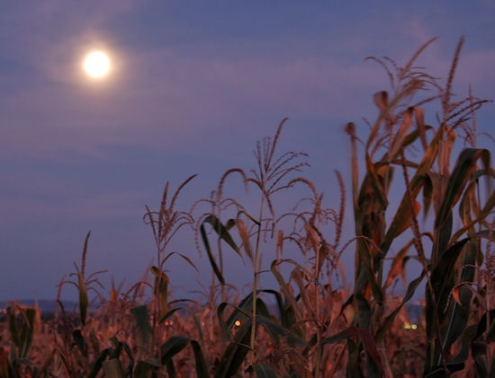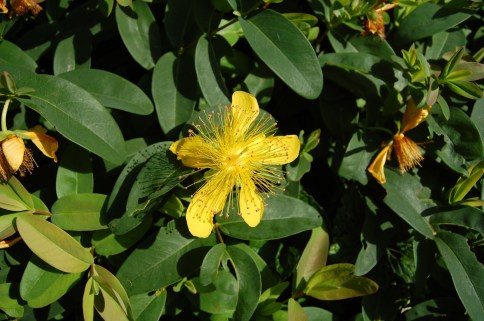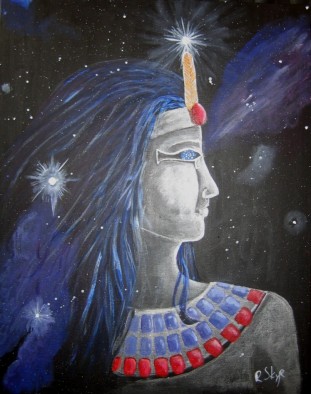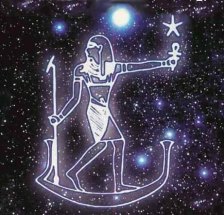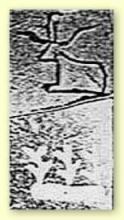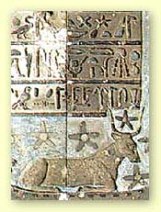Appropriate in light of remembering 9/11 and the recent tragedies…

“Nephthys” by Hrana Janto
“Nephthys’s themes are death, spirits and rebirth. Her symbols are fire, baskets and Myrrh. This Egyptian funerary Goddess had a hawk for a sacred animal. Together they guide and watch the souls of our loved ones in the afterlife. In Egyptian tradition, Nephthys lives in the east, where She can receive the rising sun, a symbol of the hopefulness she can instill and of resurrection.
Today was Nephthys’s festival day in ancient Egypt. As with other festivals for the dead, it was a time not only to propitiate the Goddess with offerings of aromatic incense like myrrh but also to satisfy any wandering spirits. If someone you care about passed away during the last year, burn some incense for this Goddess and leave a small basket filled with a token for her on your altar. This acts as a prayer to Nephthys to keep a watchful eye on that souls and grant them peace.
If you find your sense of hopefulness waning under everyday pressures, light a candle honoring Nephthys today, and every day, until you sense a difference in attitude. Try to choose a candle whose color represents hope and change to you (sprout green is one good choice). Inscribe the candle with a symbol of what you most need to turn things around so that this Goddess can shine dawn’s revitalizing light into your heart and begin relieving some of that heaviness.”
(Patricia Telesco, “365 Goddess: a daily guide to the magic and inspiration of the goddess”.)

J. Hill from Ancient Egypt Online writes: “Nephthys was an ancient Goddess, who was referenced in texts dating back to the Old Kingdom. She was a member of the Ennead of Heliopolis as the daughter of Geb and Nut and the sister of Osiris, Isis and Horus and the sister and wife of Set. When the Ennead and Ogdoad merged, Nephthys was given a place on Ra’s boat so that She could accompany him on his journey through the underworld. Nephthys is the Greek pronunciation of Her name. To the Ancient Egyptians She was Nebthwt (Nebhhwt or Nebthet) meaning ‘the Mistress of the House’. The word ‘hwt’ (‘house’) may refer to the sky (as in Hwt-hor, the ‘House of Horus’ – the name of Hathor), but it also refers to either the royal family or Egypt as a whole. The latter makes a great deal of sense as She was described as the head of the household of the gods and was thought to extend Her protection to the head female of every household. She was sometimes associated with Ptah-Tanen in representing Lower Egypt, while Khnum and Isis represented Upper Egypt.
It seems that She was originally conceived of as the female counterpart of Set. He represented the desert, while She represented the air. Set was infertile (like the desert that he represented) and was frequently described as either bisexual or gay and so Nephthys was often considered to be barren. As a Goddess of the air, She could take the form of a bird, and because She was barren She was associated with the vulture – a bird which the Egyptians believed did not bear children. The Egyptians thought that all vultures were female (because there is very little difference in the appearance of a male vulture), and that they were spontaneously created from the air. While the care shown by a mother vulture for her child was highly respected, the Egyptians also recognised that vultures fed on carrion and associated them with death and decay. As a result, Nephthys became a Goddess of death and mourning.

“Nephthys” by C. Temares
Professional mourners were known as the ‘Hawks of Nephthys’, in recognition of Her role as a Goddess of mourning. It was also believed that She protected Hapi in his role as of the Four sons of Horus (who guarded the organs stored in the four canopic jars). Hapi protected the lungs, and as a Goddess of the air Nephthys was his guardian. She was also one of the four Goddesses who guarded the shrine buried with the Pharaoh. She appears with Isis, Selkit (Serqet) and Neith on the gilded shrine of Tutankhamun, but was often depicted with Isis, Bast and Hathor in this role. Yet, She was also said to be the source of both rain and the Nile river (associating Her with Anuket) and was thought to protect women in childbirth (with the assistance of Her sister, Isis). Thus She was closely associated with both death and life.

“Nephthys” by ~deadheart82
Although She was technically infertile, later myths claimed that She was the mother of Anubis by either Osiris or Set (depending on the myth). This came about because Anubis’ position as the god of the dead was usurped by Osiris when the theologies of the Ennead and the Ogdoad merged. According to one myth Nephthys disguised Herself as Isis to get the attention of Her neglectful husband Set, but instead seduced Osiris (who apparently did not realise that it was Nephthys). An alternative myth made it clear that Nephthys intended to seduce Osiris from the beginning and drugged his wine to make Her task easier, while a less common myth held that She did trick Her husband into a brief daliance in order to concieve Anubis. It is suggested that this tale also explained the flowering of a plant in a normally barren area because Set apparently discovered the adultery when he found a flower left by his brother Osiris.
Isis and Nephthys were very close despite Nephthys’ alleged infidelity with Osiris (the husband of Isis) and Her marriage to Set (the murderer of Osiris). Nephthys protected the body of Osiris and supported Isis as She tried to resurrect him. The Goddesses are so similar in appearance that only Their headdresses can distinguish them and they always appear together in funerary scenes. Together Isis and Nephthys could be said to represent day and night, life and death, growth and decay. In Heliopolis, Isis and Nephthys were represented by two virginal priestesses who shaved off all of their body hair and were ritually pure.

Nephthys was usually depicted as a woman with the hieroglyphs of Her name (a basket on top of the glyph representing the plan of an estate) on Her head. She could also be depicted as a mourning woman, and Her hair was compared to the strips of cloth used in mummification. She also occasionally appears as a hawk, a kite or a winged Goddess in Her role as a protector of the dead. Her major centers of worships were Heliopolis (Iunu, in the 13th Nome of Lower Egypt), Senu, Hebet, (Behbit), Per-mert, Re-nefert, Het-sekhem, Het-Khas, Ta-kehset, and Diospolites.” [1]
Sources:
Hill, J. Ancientegyptonline.co.uk, “Nephthys“.
Suggested Links:
Ashwood, Moonwater. Order of the White Moon, “Nephthys: Goddess of Transition“.
Crystalinks.com, “Nephthys“.
Goddess-guide.com, “Nephthys the Egyptian Goddess“.
Monaghan, Patricia. The New Book of Goddesses and Heroines, “Nephthys“.
Seawright, Caroline. Touregypt.net, “Nephthys, Sister of Isis, Mistress of the House…“.
Touregypt.net, “Egypt: Gods – Nephthys“.
Wikipedia, “Nephthys“

